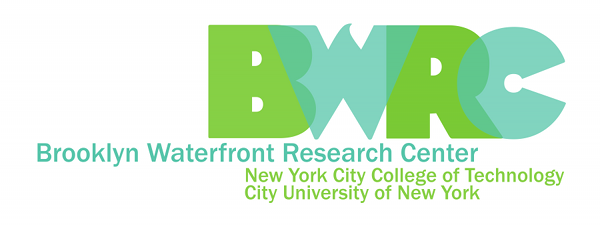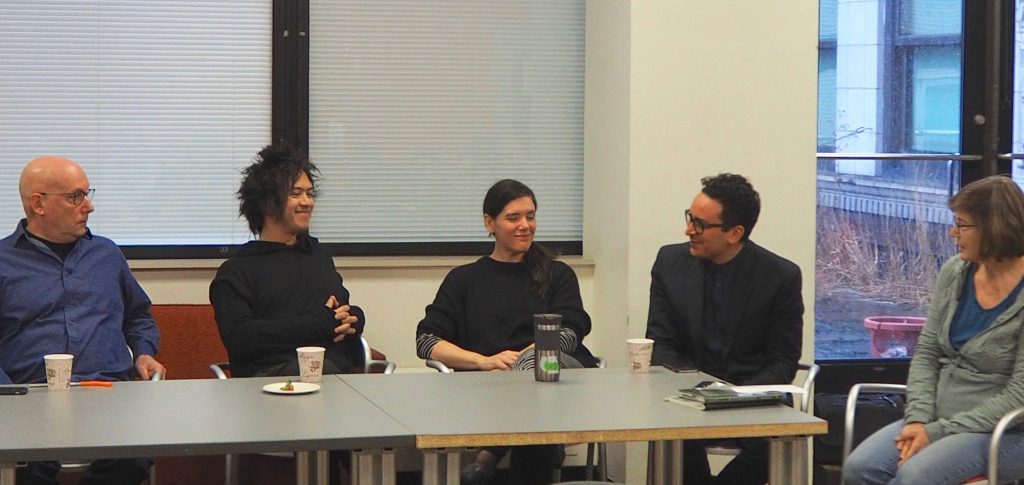The BWRC hosted a breakfast talk “Art at the Water’s Edge,” on Friday, March 2nd, which featured a panel discussion on participatory art eviactices along Brooklyn’s waterfront. Moderated by City Tech professor Robin Michals, the panelists discussed their respective creative practices and emphasized the waterfront’s role in their process, craft, and creative goals. Although they employ different media, the four artists all shared a deep commitment to place, New York City’s waterways, and civic engagement.
Dylan Gauthier, a Brooklyn based artist and educator, focuses on research-based and participatory projects that draw citizens into conversations about architecture, ecology, and urban design. Gauthier’s direct engagement with the Brooklyn waterfront began with the Empty Vessel Project in the Gowanus Canal, a project that utilized a boat as both community and performance space. Later, Gauthier launched Mare Liberum, a community boat-making initiative that uses reclaimed urban materials as the raw base materials for rowboat construction. With regular boat launches into the Newtown Creek, the Mare Liberum collective convenes community discussions that stoke critical dialogues around agemigration, urban design, and local politcs.
Sto Len, an artist and printmaker, discussed his intimate connection to the Brooklyn waterfront in his Suminagashi (floating ink) printmaking. In this process, Len creates direct prints of the surface oil traces in local waterways. As Len developed his Suminagashi process, he sought out opportunities that could connect his water-based printmaking with questions of local ecology. Eager to document the Greenpoint oil spill, Len began to generate prints from oil traces floating upon the waters of Newton Creek. Later, Len’s work carried him to Vietnam where he explored the social and ecological life of waterways. Following his Vietnam-based work, Len put up a solo show that quickly became the centerpiece of a community discussion about water quality and ecological stewardship in Vietnam.
Artist and professor, Nancy Nowacek, shared her experience of attempting to design, construct, and gain approval for Citizen Bridge, her proposed floating bridge project that would span the distance from Brooklyn’s shoreline to Governor’s Island. Through the process of prototyping, Nowacek continues to engage multiple stakeholders that range from engineers to city agencies to legal firms. Largely an iterative process, Citizen Bridge currently remains in the prototyping phase, with Nowacek actively developing and expanding the project’s community-reach.
Artist Barry Rosenthal closed out the morning panel with a compelling overview of his “Found in Nature” series. Working as an urban archeologist, photographer, and sculptor, Rosenthal culls his art objects from the trash and debris strewn along New York City’s shorelines. Later, Rosenthal turns these found objects into large-scale photography installations. Through his revolving process of culling shorelines, categorizing trash, and staging photographs, Rosenthal has amassed a mammoth archive that traces the ever-expanding ecological impact of human consumption on our immediate coastal landscapes.
Taken together, the panel showcased how waterfront art practices are effective in generating critical conversations about local ecology, politics, and community. Through varying participatory art practices, Brooklyn-based artists are opening up the waterfront and using it as a space for both creative and community-driven interventions. Critically, all the artists closed out the panel by noting collaboration’s inherent political power, emphasizing the need to involve new stakeholders while simultaneously building toward larger scales of action, policy-making, and creative production.









